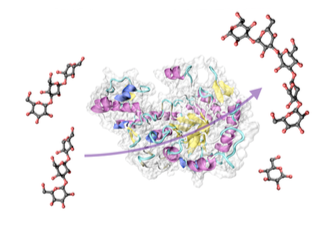A trapped covalent intermediate of a glycoside hydrolase on the pathway to transglycosylation. Insights from experiments and QM/MM simulations
A trapped covalent intermediate of a glycoside hydrolase on the pathway to transglycosylation. Insights from experiments and QM/MM simulations
L. Raich, V. Borodkin, W. Fang, J. Castro-López, D. van Aalten, R. Hurtado-Guerrero, C. Rovira.
J. Am. Chem. Soc., 138 (2016) 3325.

Enzymatic reaction catalyzed by tranglycosylases (synthesis of a glycosidic bond).
The conversion of glycoside hydrolases into transglycosylases, i.e. from enzymes that hydrolyze carbohydrates to enzymes that synthesize them, represents a promising solution for the large scale synthesis of complex carbohydrates for biotechnological purposes. However, the lack of three-dimensional enzyme structures and the limited knowledge of the enzyme molecular mechanism at atomic level hampers the rational design of these enzymes. Here we present the first crystallographic structure of a reaction intermediate of a transglycosylase enzyme in complex with an intact carbohydrate. By means of computer simulations, we demonstrate that the enzyme is tuned to catalyze the formation of a new glycosidic bond (transglycosylation reaction) and propose that the variation of a given amino acid would improve significantly the synthetic activity of this family of enzymes.
